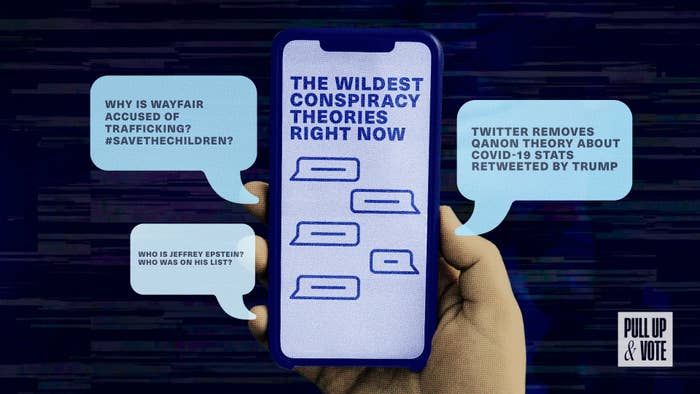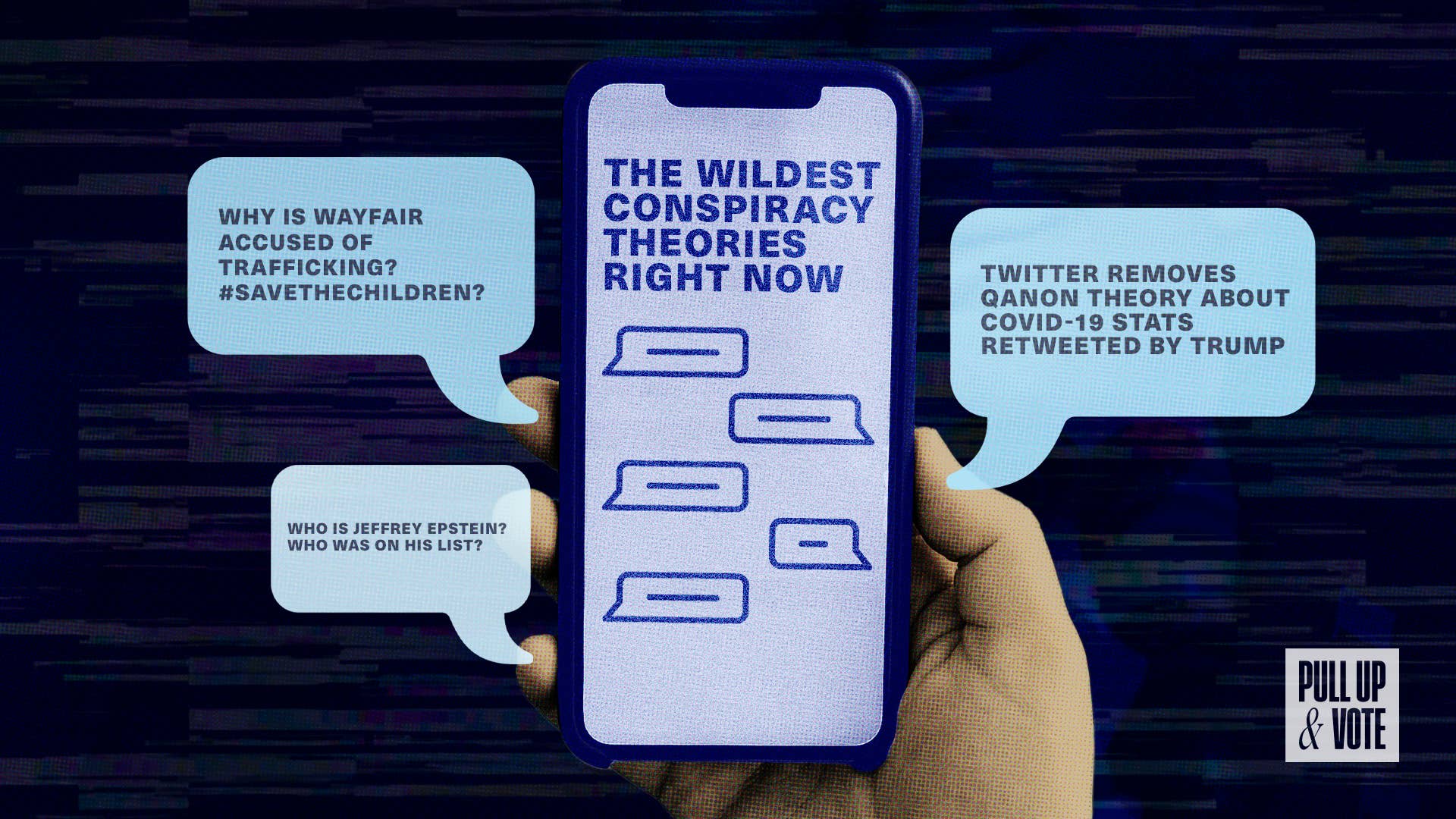
You know the old saying, “Believe nothing that you hear and only half of what you see.” These days, though word of mouth is still unreliable, you might need to adjust your glasses for more than 50 percent of what you see—especially if the claims come from TikTok, Facebook, or Instagram.
In addition to so many other things, 2020 has been the year of the conspiracy theory. Fueled by a pandemic, a global uprising for civil rights, and perhaps the most polarizing president in American history, this year has seen made up stories swallow up a huge amount of the national discourse.
From QAnon to 5G towers, conspiracy theories have been liked, shared, and memed into our lives from what seems like every angle. Luckily, no matter how many times grandma posts on Facebook about Bill Gates, there is still some semblance of truth left in this world. And so to make sure that you don’t fall deeper into the rabbit hole—and hopefully help you pull your friends and loved ones out—we’ve put together a definitive list of this year’s most popular (and thoroughly debunked) conspiracy theories.
Wayfair’s expensive cabinets are not used for child trafficking
One of the most recent conspiracy theories to take up space on national news outlets and in major daily papers is an allegation that big box e-retailer Wayfair is engaged in human trafficking by way of home cabinetry.
The rumor, which started on Reddit and quickly went viral on TikTok, claimed that product listings for exorbitantly priced cabinets, dressers, and pillows were a cover for a child trafficking ring. Because the throw pillows and office organizers sold for five-figure price tags and were often titled with women’s names like Yaritza, Alivya, and Samiyah, online skeptics immediately assumed that those product names were directly connected to missing persons, who were supposedly being sold to in-the-know predators in place of the $12,000 pieces of home and office furniture.
Despite a lack of any real evidence, it didn’t take long for the Wayfair conspiracy to leave message boards and graduate to mainstream newsfeeds. On TikTok, videos with the hashtag #wayfairconspiracy amassed more than 2.5 million views in less than a week after the conspiracy started. But almost as quickly as the screenshots of overpriced pillow listings went viral, Wayfair executives and internet sleuths debunked the dangerous rumors.
In late July, a Wayfair representative told Newsweek, “There is, of course, no truth to these claims. The products in question are industrial grade cabinets that are accurately priced. Recognizing that the photos and descriptions provided by the supplier did not adequately explain the high price point, we have temporarily removed the products from the site to rename them and to provide a more in-depth description and photos that accurately depict the product to clarify the price point.”
And as any connoisseur of home goods, furniture, or even fashion will tell you, giving products human names is a pretty common industry practice and does not insinuate that the item is sold alongside a person with the same name—no matter how pricey the cabinet is.
No, 5G towers didn’t cause COVID-19
Sure, fast download speeds on your unlimited data plan are nice, but is 5G getting you sick? In the first month of 2020, when the COVID-19 outbreak in Wuhan, China, first made global headlines, a fringe website in France published a story linking Wuhan’s 5G data towers with the novel coronavirus. The baseless conspiracy claimed that the millimeter-wave spectrum used to transmit internet data to handheld devices was interfering with the body’s natural chemistry and making people sick.
As the virus spread from Asia to Europe and then to the US, so did the 5G theories. Before long, hardcore believers of the completely false COVID-19 origin story took their passion offline, setting fire to 5G network towers in the Netherlands, Ireland, and Cyprus with more than 100 individual instances of 5G infrastructure arson across the UK.
Like all conspiracy theories these days, the COVID-19/5G connection jumped from fringe to front pages with the help of social media. This time, the kindling for the fire—both figuratively and literally—was Facebook. In Bolivia, where there are zero 5G towers in the entire country, the conspiracy was so prevalent that believers inexplicably burned down regular antennas.
5G conspiracy theories have been around before COVID-19, but experts around the world in both tech and medicine have repeatedly shot down the rampant rumors, stating unequivocally that wireless data towers do not transmit coronavirus. Check your notifications and send those emails without fear, WiFi or not.
Who is Q? QAnon theories run wild on Facebook
The QAnon conspiracy started in 2017 as a web post on the 4Chan message board, but in 2020 it has grown so big that avowed believers are now running for public office. Despite its growing popularity, QAnon might be the most outlandish conspiracy theory of the current era.
At its core, QAnon is a far-right theory centered around Donald Trump, a supposed cabal of celebrity sex traffickers, and “the deep state.” The fact-free fascination is the work of an anonymous (that’s the anon part) 4Chan poster named Q. Since 2017, Q—who claims to be a government employee with top-secret security clearance—has left cryptic breadcrumbs, puzzles, and clues aimed at ardent followers. Using wild speculation and deductive skills untethered from reality to break down those hints, QAnon followers have constructed a worldview in which president Trump is leading a hidden crusade against a well-connected network of child predators in the media, government, and Hollywood.
QAnon theories have direct ties to other conspiracy theories like “Pizzagate” and use real-world instances of sex trafficking like the high-profile Jeffery Epstein case as jumping-off points, but from there they pervert any facts to fit their false narrative of Trump as an anti-child molester superhero.
Outside of 4Chan, QAnon conspiracies have found a home on Facebook and Twitter, where, unlike the 5G and Wayfair conspiracies, older Americans are liking, sharing, and proliferating the absurd theories. Recently, in an attempt to corral the rapid spread of QAnon rumors, both Facebook and Twitter have begun banning pages associated with QAnon. On Twitter, the clean-up is expected to eliminate more than 150,000 accounts. Still, despite rebukes from the social media giants, QAnon believers are pushing further and further into the mainstream, with some Q truthers even running forelected office.
Like all of the theories on this list, there is zero proof behind the entire QAnon conspiracy.
Anti-malaria drugs do not cure COVID-19
The pharmaceutical drugs hydroxychloroquine and chloroquine have been used for decades to combat malaria, but will they also work to cure COVID-19? Despite what you may have heard in presidential news briefings, the answer to that question is a resounding and emphatic “no.”
While most of the theories to take hold this year have come from faceless social media figures or fringe fake news sites, the unfounded claims about COVID-19 and antimalarial drugs came straight from the White House. In March, Trump announced publicly that he believed the antimalarial drugs “could be something really incredible,” in the treatment of COVID-19, despite negligent amounts of scientific research backing the claim. Trump said that he took the drugs after encountering two people who later tested positive for COVID-19.
In the weeks and months that followed, prescriptions of hydroxychloroquine and chloroquine spiked as Americans sought out the supposed COVID-19 cure. In late March, the FDA even approved expanded emergency use of the drug to fight coronavirus that was revoked less than three months later in mid-June.
Even in the face of continued scientific study disproving the president’s claims, amateur pharmacologists on social media have persisted in pushing conspiracy theories about the antimalarial drugs. Unfortunately, there is still no known cure for COVID-19, and the only way to make sure you are safe is to avoid social gatherings and wear a mask in public. Sorry, no shortcuts.
Anti-vaxxers think Bill Gates wants to involuntarily embed microchips into the human body
Alongside QAnon diehards, anti-vaccination advocates are some of the country’s most vocal and prominent conspiracy theorists. And as COVID-19 spread, vaccination skeptics quickly grasped onto the idea of an eventual coronavirus vaccine and started spinning webs of far-fetched fantasy.
Among the most common anti-vaxxer COVID-19 theories is a claim that billionaire Microsoft founder Bill Gates is using well-funded philanthropic research efforts as a smokescreen to mask more sinister motives. On YouTube and Facebook, videos and poorly sourced news stories with millions of views assert that Gates plans to embed microscopic tracking devices inside of a COVID-19 vaccine to covertly surveil the US population.
In February of this year, Gates and his wife Melinda donated $100 million to the World Health Organization to help scientists develop a COVID-19 vaccine. According to media analysis company Zignal Labs, by April more than 16,000 Bill Gates COVID-19 stories had been shared on Facebook alone. Come July, conspiracy theories about the donation had gained so much traction that Gates released a statement to the media denying the rumors.
“We need to get the truth out there,” Gates said during an interview on CBS News. “I hope it’ll die down as people get the facts.”
Besides the fact that Gates himself is not inside of any laboratory working on potential COVID cures, the scientific community is still a ways away from even creating a coronavirus vaccine, never mind adding a state-of-the-art tracking device with a direct link to Gates’ personal Zune. Suffice it to say, you should be more worried about facial recognition, CCTV, and constant data collection than you should sci-fi stories about Bill Gates installing Windows XP in your bloodstream.
Still not sure how to tell if something you read online is fact or fiction? Make sure to pay attention to sourcing, take proclamations on social media with a grain of salt, and always go with your gut. That is, unless your gut still tells you that aliens aren’t real, because, you know, aliens are totally real.
Don’t forget that you can do your part by visiting Complex's Pull Up & Vote site—where you can double-check your registration, register to vote if you haven’t, and request a mail-in ballot.

